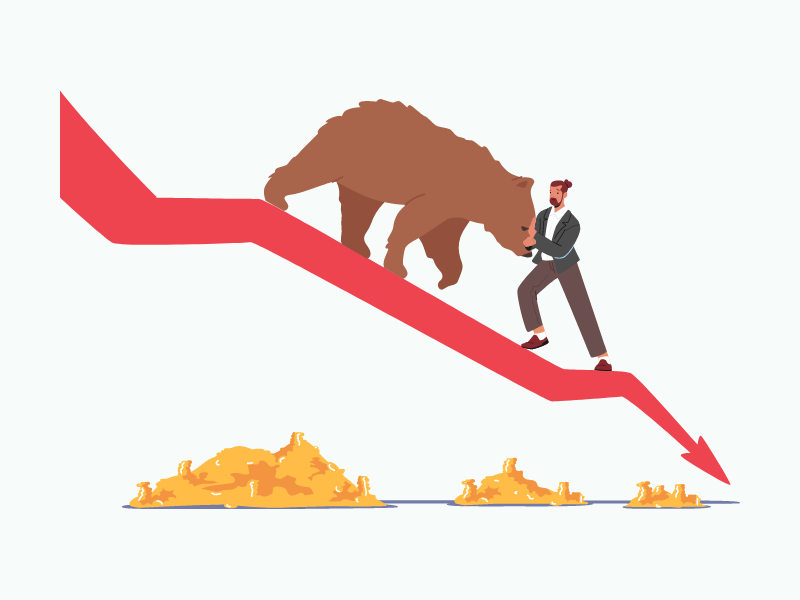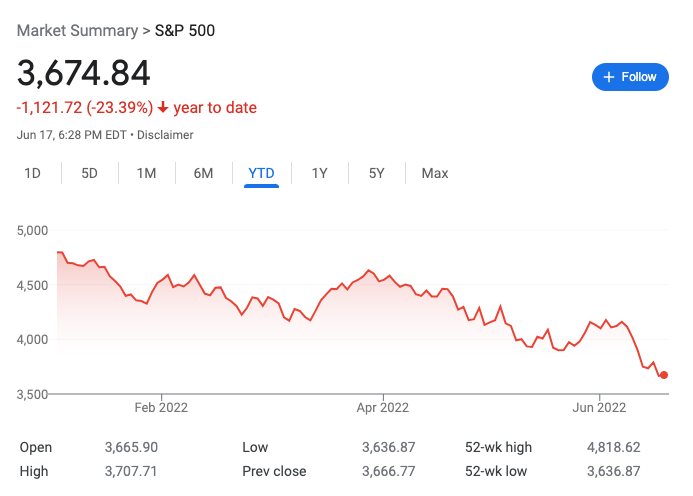My Investing Strategy For This Bear Market

I had another email scheduled to be sent out today. But, given that we have officially entered a bear market, I figured I should address current market conditions and how to move forward.
This past week, a few things shook the stock market and spread fear among people and their investing plans. Let’s recap what happened:
1. The Stock Market Entered a Bear Market

The S&P 500 is an index fund that tracks the performance of the largest 500 companies in the United States. In order for us to enter a bear market, there must be a decline of 20% or more in the overall market, which is represented by the S&P 500 for most people.
This week, the S&P 500 has a decline of -23% from the start of this year. This officially means that we are in a bear market, which is viewed negatively by most people because it means that our economy is slowing down.
Historically, fear in the market right now is understandable since there is a high chance that we will enter a recession.
This is obviously not good news, as recessions result in job losses, salary cuts, and slower economic growth.
Furthermore, the average economic decline during recessions is around 30–40%. Given that we are only at a 23% decline, we can anticipate the market to continue falling in the upcoming weeks and months, although not guaranteed.
2. Inflation reaches 8.6%

The Fed announced that our inflation rate rose from 8.3% (April) to 8.6% (May), the highest it has been in over 40 years.
To simply put it, inflation is the decrease in your purchasing power over time. Your purchasing power is the number of goods a unit of currency can buy.
For instance, in 2000, the retail value of a gallon of milk cost just $2.79. Today, that same gallon of milk has an average retail value of $4.33.
That demonstrates the decrease in your purchasing power in the span of two decades. That is not due to a scarcity of milk, but rather to your currency's inability to purchase the same amount of goods over time; this is known as inflation!
Since inflation keeps increasing, that means the price of goods continues to increase. This puts a burden on the consumer (us) because our employers are not increasing our salaries to match inflation.
Therefore, our paycheck is unable to buy us the same number of goods and services as it used to.
If you drive a car, then I am sure you have already noticed this because of the crazy gas prices that we have seen lately. If not, take a closer look at your past trips to the supermarket and see if you are spending more money buying your weekly groceries.
3. The Federal Reserve raises interest rates by 0.75 percentage point.

In order for inflation to be controlled, the amount of circulating money in the market also needs to be controlled.
In order to do this, the Fed raises interest rates to bring down inflation. When interest rates go up, it becomes more expensive for people to borrow money. This results in fewer people borrowing money, which decreases the amount of money spent.
This week, it was announced that interest rates would increase by 0.75% instead of the expected 0.50%.
When interest rates go up, people become fearful because they now want to save more of the money they have in case something goes wrong.
When consumers spend less money, inflation tends to come back down because the demand is not there anymore and high prices will come down.
My Investing Strategy

Now that we know why the market has been free-falling all week, let’s look at how I am playing my cards during all of this.
It is possible that we are in a recession right now, but there is no way we can determine when it will be over and when the market will reverse and continue to grow once again.
This is why it is important to have a plan and strategy outlined before you start investing. Personally, I have a long-term investing strategy, so any short-term declines like this do not worry me.
Since we will possibly decline another 10-15%, I will continue to dollar-cost average in my current stock positions. That is, whether the market continues to fall or begins to slowly recover, I will continue to buy the same amount at the beginning of each month.
In addition, I will buy with a larger sum of money at every 10% decline. So, I will deposit a larger sum of money when the overall market is at -30%, -40%, -50%, and so on. The reason being is that, historically, recessions reached a low of around -30% to -40%.
You can read my guide on recession investing here.
The amount I am investing on a monthly basis looks like this:
- 401K: $500/month
- Roth IRA: $1000/month
- Brokerage Account: $1000/month
- Cryptocurrency: $100/day
I also want to point out that the current slaughter happening in the stock market is dramatically affecting the cryptocurrency market. This resulted in the overall crypto market value falling below $1 trillion for the first time since January of 2021.
This will result in a lot of cryptocurrency projects falling out, which is why I’m currently only buying Bitcoin and Ethereum. Every day, I buy $50 of Bitcoin and $50 of Ethereum.
Have a great week!
Muhamed
📖 Quote of the Week
The S&P 500 increased 119-fold in the 50 years ending 2018. All you had to do was sit back and let your money compound. But, of course, successful investing looks easy when you're not the one doing it. "Hold stocks for the long run," you'll hear. It's good advice. But do you know how hard it is to maintain a long-term outlook when stocks are collapsing?
From The Psychology Of Money, By Morgan Housel

